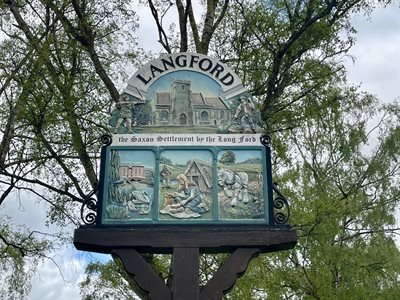The Parish of Langford in General
This page was contributed by Edward Martin

Langford High Street c.1905 [Z1130/71/6]
Langford is three miles (5 km) south of Biggleswade and is a long straggling village. It now starts at the Baulk Corner and it is nearly three miles to the Running Waters at the north end of the village. Langford lies in the valley of the River Ivel and dates from Saxon times. The village is restricted on the east by the East Coast railway and on the west by the River Ivel. It was first mentioned in AD 944. There were once one or more fording points across the river and the village is said to take its name from the words ‘long ford’, alluding to the length of the settlement. Before 1066 the Lord of Langford was Lewin, a thane of Edward the Confessor. William the Conqueror granted the village to Walter le Fleming. The Domesday Book in 1086 records the population of ‘Langeford’ as 21 and the landholder as Walter le Fleming and that there were 2 mills. In 1142 Walter’s descendant Simon de Wahull gave land to the Knights Templar, who established themselves as Lords of the Manor of Langford Rectory. Langford has had absentee lords of the manor throughout its history.
The west side of the River Ivel is part of the Ivel Valley countryside project, namely, Henlow Common and Langford Meadows local nature reserve. This 47 acre reserve, despite being called Henlow Common is situated in Langford parish. It came to Langford in 1985 after an exchange of land between the two parishes and as a registered common it keeps its original name. The village has grown enormously since 1961 when the population was 1,379; by 1976 it had doubled to 2,500; in 2001 it was 2,876; in 2011, 3,091 and in 2018, 3,281 and there has been more residential development since.
As Langford was mainly a small agricultural community great events tended to pass it by but research is ongoing to glean what can be found of its previous inhabitants or of things that have happened:
Reference: Michael Rutt, The People at the Long Ford (Bedfordshire County Council, 1975)

Langford Village Sign, 2024
Name
The name is believed to derive from the words ‘long ford’ alluding to the length of the settlement. The name has not changed very much over the years.
- 944: Longaford
- 1086: Langeford
- 1428: Langford
- 1498: Langforth
- 1610: Langford
Administrative History
Langford is an ancient parish in the Biggleswade Hundred which includes: Astwick, Little Barford, Biggleswade, Potton, Sandy, and others. There are two tiers of local government covering Langford, at parish and unitary authority level: Langford Parish Council and Central Bedfordshire Council. Prior to 1894, Langford was administered by the Hundred. From 1894 to 1974 it was in Biggleswade Rural District and from 1974 to 2009 in Mid Bedfordshire District. Mid Bedfordshire and Bedfordshire County Council were both abolished 2009, when Langford became part of the unitary authority of Central Bedfordshire.
Population
The figure of 21 given in the Domesday Book of 1086 would have been just men, and when multiplied by four to account for their households the population figure would likely have been between 80 and 90.
The Hearth Tax of 1671 records 73 dwellings in Langford for a total of 122 hearths. It has been estimated that this represented a population of about 302. The largest number of hearths - 6 - were in the house of Thomas Wills.
Population figures for Langford given in the censuses from 1801 to 2011 are as follows:
- 1086: 96
- 1671: 302
- 1676: 312
- 1801: 458
- 1841: 840
- 1881: 1,242
- 1921: 1,205
- 1961: 1,379
- 2001: 2,882
- 2011: 3,091
- 2021: 3,712